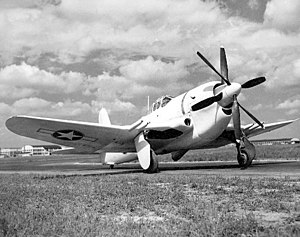Curtiss XF14C
| XF14C | |
|---|---|

| |
| Role | Carrier-based fighter |
| National origin | United States |
| Manufacturer | Curtiss-Wright |
| First flight | July 1944 |
| Status | Canceled |
| Primary user | US Navy |
| Number built | 1 |
The Curtiss XF14C was an American naval fighter aircraft. It was developed by Curtiss-Wright in response to a request by the United States Navy in 1941 to produce a new shipboard high-performance fighter aircraft.
Design and development[]
In 1941 the US Navy requested a better-performing carrier-based fighter plane, to be powered by the proposed high performance 24-cylinder liquid cooled Lycoming XH-2470 Hyper engine. This was an unusual step for the Navy, which had been adamant to that time that all its aircraft use air-cooled radial engines.
On June 30, 1941 a contract for two prototype aircraft, designated the XF14C-1, was awarded to the Curtiss-Wright company. On the same date prototype development contracts were also awarded to Grumman Aircraft Engineering Corporation for the single-engine XF6F-1 and the twin engine XF7F-1, both of which would use air-cooled Pratt & Whitney R-2800 Double Wasp radial engines.
Early in the development the Navy requested better altitude performance and, in view of unsatisfactory progress in the development of the XH-2470 engine, Curtiss adapted the design of the aircraft around the new turbocharged Wright R-3350 Duplex-Cyclone air-cooled radial engine. The aircraft equipped with this eighteen-cylinder twin-row radial air-cooled engine and three bladed contra-rotating propellers was designated the XF14C-2. The XF14C-1 was canceled. Also, looking at the problems of operation at altitudes of about 40,000 feet (12,000 m), the Navy also initiated work on a third version with a pressurized cockpit designated the XF14C-3.
Ultimately, only the XF14C-2 prototype was completed, flying for the first time in July 1944. Moreover, disappointment with performance estimates and delays with the availability of the XR-3350-16 engine coupled with the evaporating tactical need for an extremely high-altitude fighter led to cancellation of the development.
Specifications (XF14C-2)[]
Data from Curtiss Aircraft 1907–1947[1]
General characteristics
- Crew: 1
- Length: 37 ft 9 in (11.51 m)
- Wingspan: 46 ft 0 in (14.02 m)
- Height: 17 ft 0 in (5.18 m)
- Wing area: 375 sq ft (34.8 m2)
- Empty weight: 10,531 lb (4,777 kg)
- Gross weight: 14,950 lb (6,781 kg)
- Powerplant: 1 × Wright XR-3350-16 eighteen cylinder twin row air-cooled radial engine
- Propellers: 6-bladed contra-rotating constant-speed propeller
Performance
- Maximum speed: 418 mph (673 km/h, 363 kn) at 32,000 ft (9,800 m)
- Cruise speed: 172 mph (277 km/h, 149 kn)
- Range: 1,530 mi (2,460 km, 1,330 nmi)
- Service ceiling: 39,800 ft (12,100 m)
- Rate of climb: 2,700 ft/min (14 m/s)
Armament
- Guns: 4 × wing mounted 20 mm (0.787 in) cannon (planned)
See also[]
Aircraft of comparable role, configuration, and era
- Boeing F8B
- Hawker Sea Fury
- Focke-Wulf Ta 152H
- Nakajima Ki-87
Related lists
- List of fighter aircraft
- List of United States Navy aircraft designations (pre-1962)
References[]
| Wikimedia Commons has media related to Curtiss XF14C. |
Notes[]
- ^ Bowers, Peter M. (1979). Curtiss aircraft, 1907-1947. London: Putnam. pp. 439–440. ISBN 0370100298.
Bibliography[]
- Bowers, Peter M. Curtiss Aircraft, 1907–1947. London, UK: Putnam & Company Ltd., 1979. ISBN 0-370-10029-8.
- Green, William. War Planes of the Second World War - Fighters, vol. 4. London, UK: MacDonald, 1961. ISBN 0-356-01448-7.
- Green, William and Swanborough, Gordon. WW2 Aircraft Fact Files: US Navy and marine Corps Fighters. London, UK: Macdonald and Jane's Publishers Ltd., 1976. ISBN 0-356-08222-9.
- 1940s United States fighter aircraft
- Low-wing aircraft
- Single-engined tractor aircraft
- Curtiss aircraft
- Aircraft with contra-rotating propellers
- Aircraft first flown in 1944